Are you interested in using the Avalanche network for your next Web3 project? If so, you must use the Fuji testnet and Avalanche faucets before deploying to the network’s mainnet. Sounds complicated? Thanks to Moralis, the process becomes straightforward, and you can easily set your default chain to Avalanche’s Fuji testnet with the following code snippet:
import Moralis from 'moralis';
import { EvmChain } from '@moralisweb3/common-evm-utils';
Moralis.start({
apiKey: 'YOUR_API_KEY',
defaultEvmApiChain: EvmChain.FUJI
})
Whether you are a developer looking for technical information on how to use the Fuji testnet or just want an answer to the “what is the Fuji testnet?” question and want to know how Avalanche faucets work, this article’s content is for you! Want to start building on the Fuji testnet right away? Click the button below:
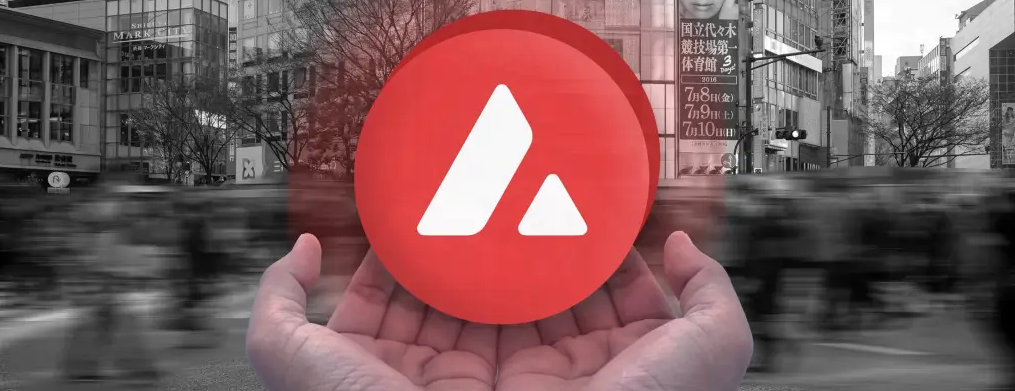
Overview
There’s been a lot of talk about the Avalanche blockchain since its launch in 2020. Many believe that this chain has the potential to overthrow Ethereum and take the number one spot on the leaderboard of programmable blockchains. However, no one really knows which chain will conquer the market in the future, and staying up-to-date with the latest information regarding potential “Ethereum killers” is definitely a good idea. As such, Avalanche certainly deserves your attention. This programmable blockchain enables you to launch dapps and smart contracts just like on Ethereum. You might already know this, but to deploy smart contracts and execute on-chain transactions related to dapps, you need to execute on-chain transactions. While doing so, you don’t want to burden the Avalanche mainnet nor waste AVAX funds until you are sure your code is working properly. This is where the Fuji testnet and Avalanche faucets enter the scene.
In today’s article, we will provide you with all the information you need to start using the Fuji testnet and Avalanche faucets confidently. We’ll do this by answering important questions such as, “what is the Fuji testnet?”, “what is Avalanche?”, and “what are Avalanche faucets?”. You will also learn that building on the Fuji testnet is much simpler than you think. In fact, if you have some experience with legacy programming, you can start building dapps on Fuji starting today. After all, you just need a free Moralis account, MetaMask, and some Fuji AVAX, which you can get via a reliable Avalanche faucet.

What is the Fuji Testnet?
The Fuji testnet is Avalanche’s public network for testing dapps (decentralized applications) and smart contracts. Like any other testnet that serves its mainnet, Fuji enables Avalanche developers to test various functionalities. This also allows the core Avalanche community to test any updates before applying them to the mainnet. In addition to testing updates, dapps, and smart contracts, Fuji enables projects to test public engagement. After all, anyone can use this public testnet. Fuji is essentially the “sandbox” environment for anyone interested in building on Avalanche.
It’s also worth repeating that blockchain transactions require gas fees. The latter is paid in chains’ native currencies (ETH for Ethereum, BNB for BNB Chain, MATIC for Polygon, etc.). With that in mind, it’s clear that performing test transactions on mainnets could be very costly. It would also be pretty irrational to store on-chain data for testing purposes immutably. So, all testnets, including Fuji, are technical and economical solutions that provide a more seamless developer experience!
Following the rule that a testnet should resemble its mainnet as much as possible, Fuji is normally on the same version as the Avalanche mainnet. But there are rare occasions when the testnet may be running an unreleased version of Avalanche. Still, it’s safe to expect that Fuji mimics the behavior of its mainnet. After all, this adds proper weight to testing.
This also means that you can use the same tools for both networks. This mimicking of the mainnet also requires testnets to utilize gas fees to execute transactions. Accordingly, you need the correct coins – Fuji AVAX – to cover those gas fees. That’s where Avalanche faucets come to play.
Note: We will dive into Avalanche faucets in the “What are Avalanche Faucets?” section further down in this article!

What is Avalanche?
Avalanche is one of the leading EVM-compatible blockchains, which means that its smart contract capabilities follow Ethereum Virtual Machine’s lead. This chain was launched back in 2020 by Ava Labs on the wings of Cornell professor Emin Gün Sirer. His two students – Kevin Sekniqi and Maofan “Ted” Yinmain – were his main supporters and contributors.
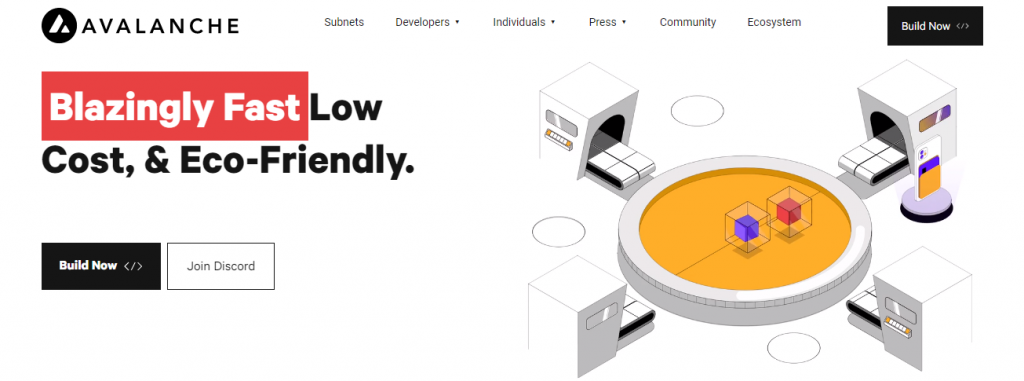
The main benefits of Avalanche come in the form of speed, interoperability, low fees, and eco-friendliness. According to Ava Labs, this chain can handle up to 4,500 transactions per second (TPS). In comparison, Bitcoin supports seven transactions per second, and Ethereum 14. Avalanche is also able to achieve transaction finality in less than three seconds. These capabilities make Avalanche more suitable for scalable dapps. Thanks to its subnet design (X-Chain, C-Chain, P-Chain) and the ability for blockchains to communicate with one another both within and between subnets, Avalanche also supports cross-chain interoperability.
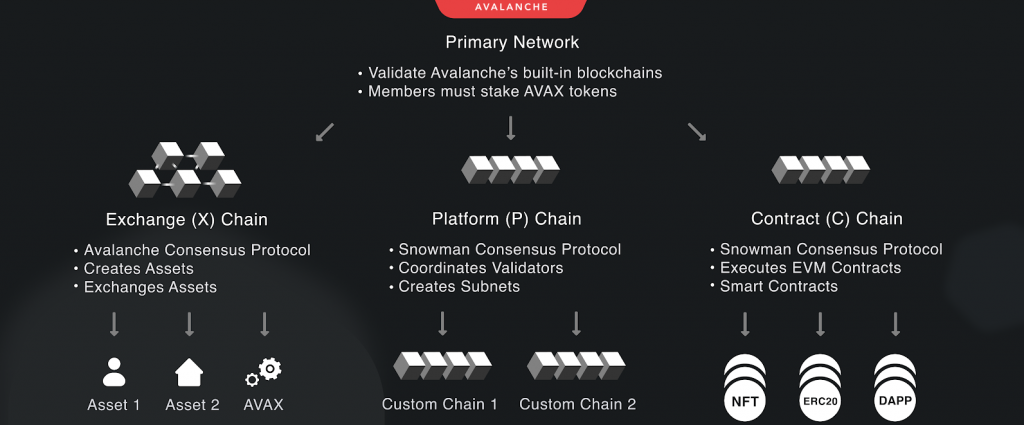
By design, Avalanche offers the potential to solve several issues, including network congestion and high transaction fees. After all, Avalanche’s fees are significantly less expensive than Ethereum’s. If you are interested in learning more about the Avalanche network and its consensus mechanisms, visit Avalanche’s documentation.
Now that you can answer the “what is the Fuji testnet?” question confidently and understand the basics of Avalanche, it’s time you find out how to start building dapps on the Fuji testnet the easy way.
Building on the Fuji Testnet
Unless you’ve been living under a rock, you know that Moralis is the ultimate Web3 API provider. It enables you to incorporate all sorts of Web3 functionalities with short code snippets, such as Web3 authentication. Also, Moralis lets you fetch any on-chain data with its powerful Web3 Data API. In most cases, a single line of code does the trick. Plus, thanks to Moralis’ Streams API, you can listen to wallet and smart contract addresses. This enables you to use live on-chain events as triggers for your dapp functionalities or user notifications.
Avalanche and Fuji are just two of many chains that this Web2-Web3 dev bridge supports. As such, you can start with Fuji and Avalanche but easily port your dapps to other chains. Aside from its cross-chain interoperability, Moralis is also all about cross-platform interoperability. Accordingly, you can use your legacy programming skills to join the Web3 revolution.
What’s more, a free Moralis account is all you need to get access to all these amazing tools! Now, let’s look at how Moralis provides the easiest way to build on Avalanche’s Fuji testnet.
TRUSTED BY INDUSTRY LEADERS




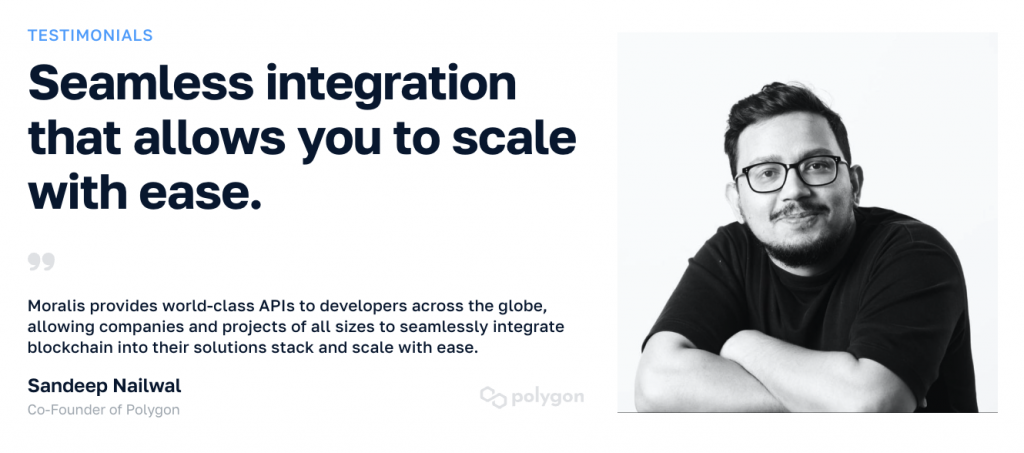
How to Target Fuji Testnet with Moralis and MetaMask
With your free Moralis account ready, you’ll be able to start using Moralis’ endpoints for all supported chains. To target Fuji, you must use this network’s chain ID or simply replace the default “EvmChain.ETHEREUM” with “EvmChain.FUJI“.

Using the snippet of code below, you can also set Fuji as your default chain for testing:
import Moralis from 'moralis';
import { EvmChain } from '@moralisweb3/common-evm-utils';
Moralis.start({
apiKey: 'YOUR_API_KEY',
defaultEvmApiChain: EvmChain.FUJI
})
When working with Moralis, you should also utilize the API reference pages in the Moralis documentation. On these pages, you can simply select “Avalanche testnet” or “0xa869” (chain ID in hexadecimal format):
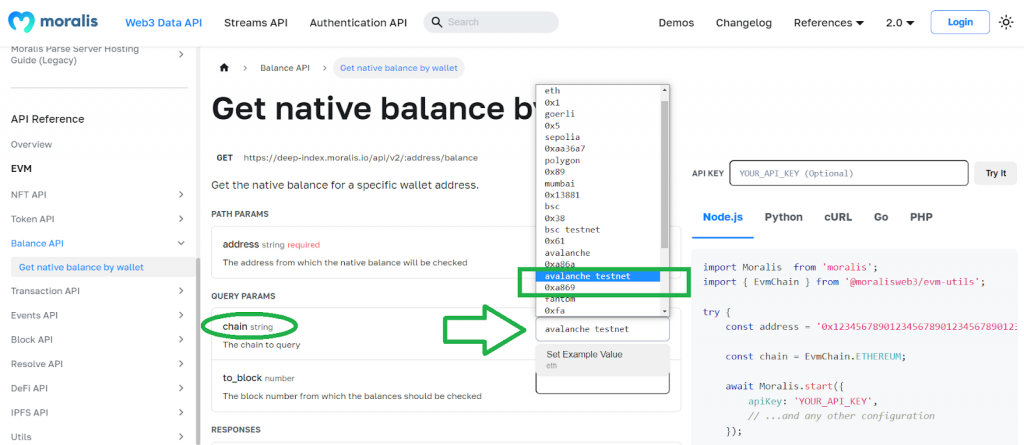
If you decide to use the Moralis admin dashboard to create new streams, you’ll be able to simply toggle the “Avalanche Testnet” option in the third step on the “Stream Configuration” page:
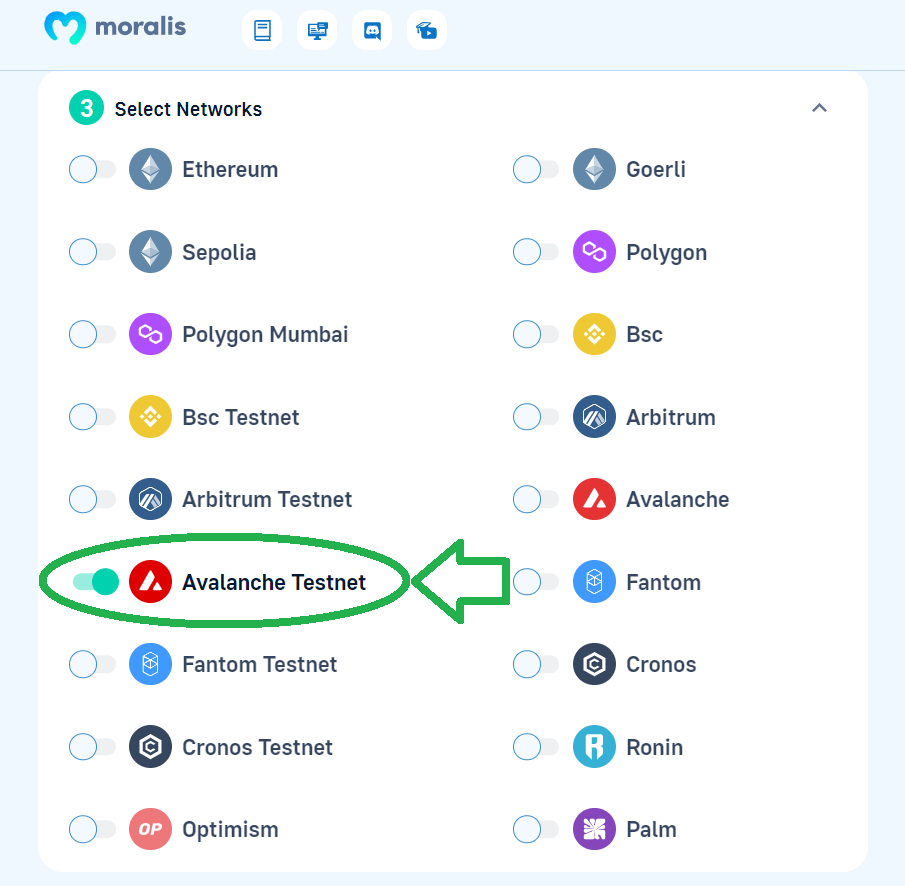
You also need to obtain your Moralis API key if you want to start building dapps the easy way on Fuji or any other supported mainnets or testnets. Fortunately, you can get that key in two simple clicks:
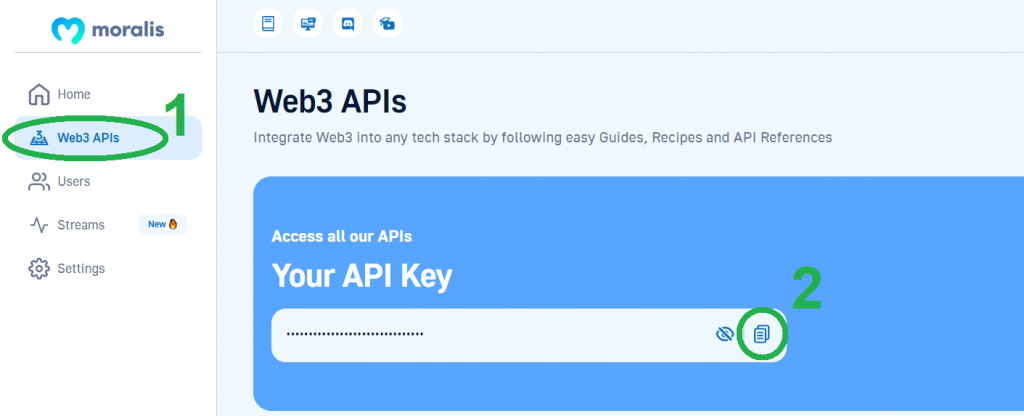
Also, do not forget to add Fuji to MetaMask via its “Add network” button:
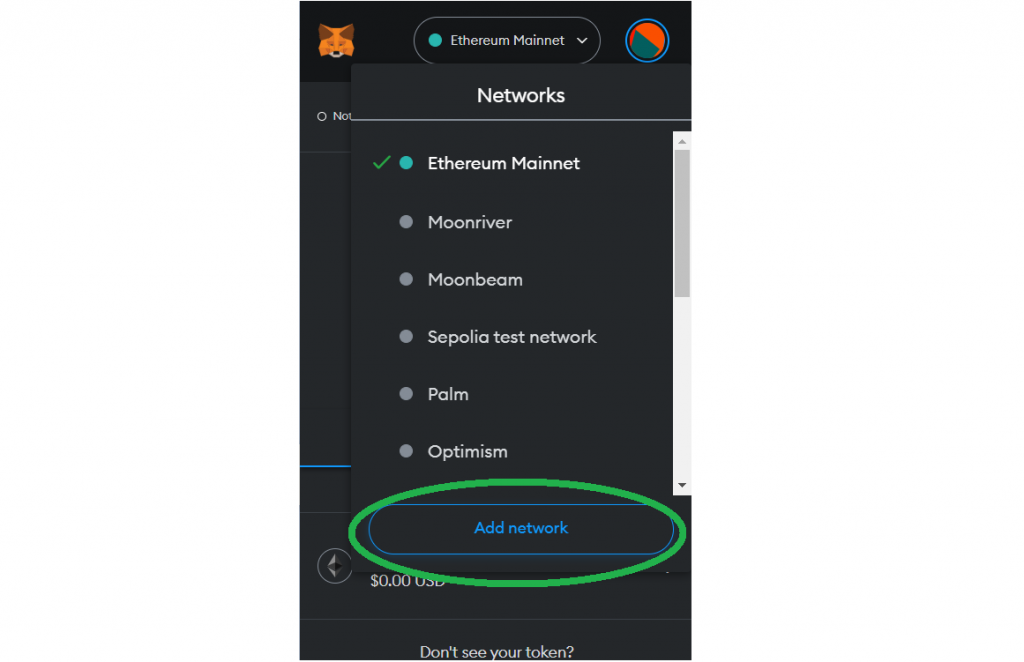
Then, you’ll be able to enter the following details to connect to the Fuji testnet:
- Network Name: Avalanche Fuji C-Chain
- New RPC URL: https://api.avax-test.network/ext/bc/C/rpc
- ChainID: 43113
- Symbol: AVAX
- Explorer: https://testnet.snowtrace.io/

What are Avalanche Faucets?
Avalanche faucets are crypto faucets that focus on providing Fuji testnet coins: Fuji AVAX. Just like most testnet faucets, Avalanche faucets typically come in the form of web applications. These apps enable visitors to input their wallet address and hit a confirmation button. In return, users receive a small amount of test AVAX. On the other hand, some Avalanche faucets may require you to connect your wallet, in most cases MetaMask. That’s also why we illustrated how to add the Avalanche testnet to this most popular crypto hot wallet in the previous section.
Some Avalanche faucets may come in the form of social media engagement requests. With those, you need to perform some type of action (e.g., retweet, comment, etc.). In return, you’d receive some Fuji AVAX. That said, it can be challenging for devs to find reliable testnet faucets. Moralis fixes this, and you’ll learn how in the next section.
Unlike the native AVAX coin on the Avalanche mainnet, which you must buy on an exchange, test cryptocurrency is free. This means that anyone with a Web3 wallet and the ability to connect to the Fuji network can obtain Fuji AVAX. But keep in mind that all faucets, including those for Fuji, limit the amount of the test currency you can get per transaction per day (or other timeframes).
So, the next time someone asks you, “what is the Fuji testnet faucet?”, you can tell them it’s a tool that provides devs with Fuji AVAX to test on-chain transactions. To point them towards a reliable Fuji faucet, make sure to explore the testnet faucet from Moralis.
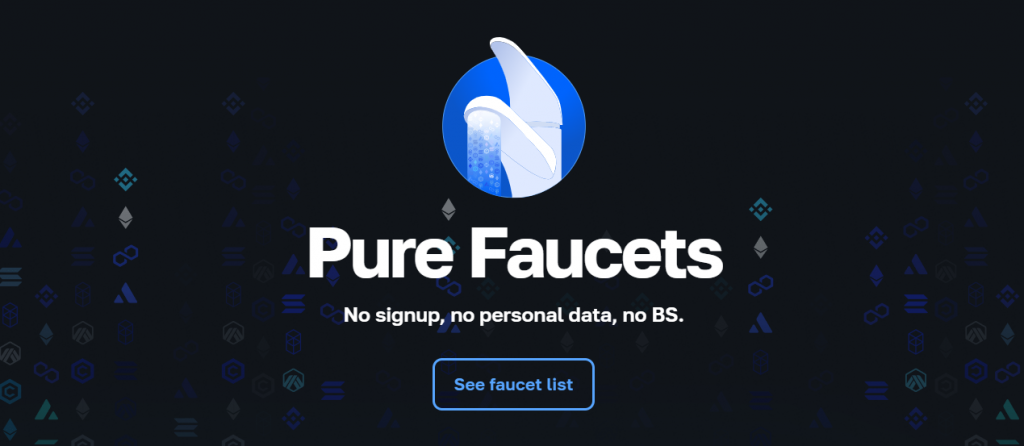
Get Avalanche Testnet Faucet Funds
It’s time we show you how to use the best Avalanche faucet, which is one of Moralis’ Pure Faucets. As developers, we are tired of complicated and untrustworthy faucets. Devs should be able to obtain test cryptocurrencies in a safe and hustle-free way. Thus, we created a carefully curated list of pure faucets that meet the following criteria:
- Easy to use
- Never require any signup
- Provides a great low-friction experience for developers
So, if you are tired of searching for reliable Avalanche faucets online, just click on the above “Avalance faucet” link. Once on that page, scroll down or simply click on the “See faucet list”. Then, hit the “Try Now” button next to “Avalanche Fuji Testnet Faucet”:

You will land on the following faucet page:
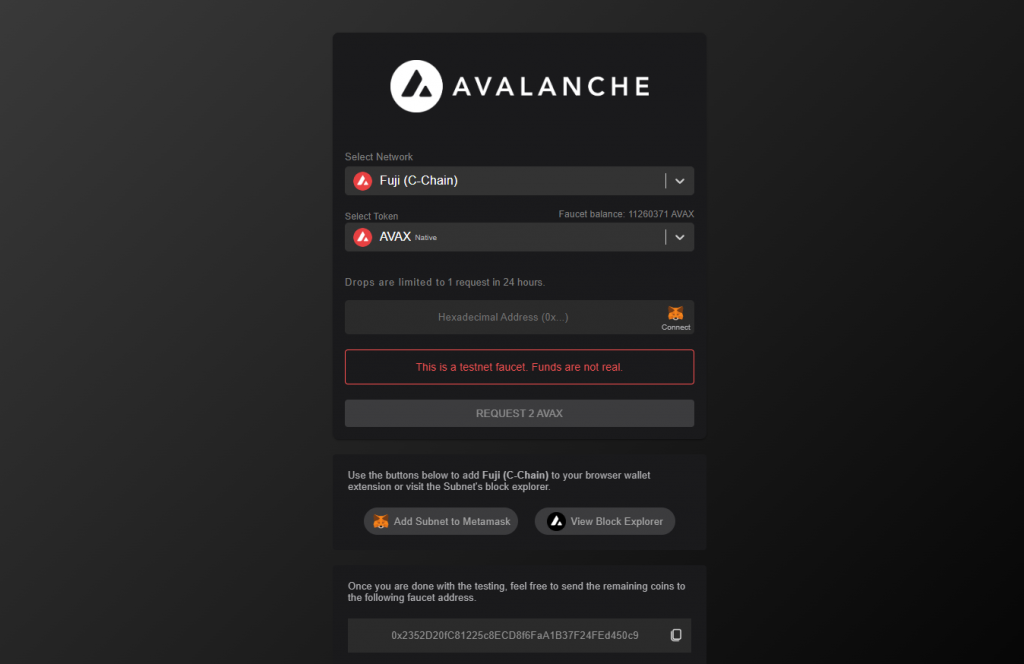
Looking at the above screenshot, you can see that “Fuji (C-Chain)” is set as the default network and that “AVAX” is set as the default token. You can also see that this faucet allows you to get two AVAX per day.
Next, you need to paste your wallet address in the “Hexadecimal Address (0x…)” entry field. You can also connect your MetaMask by clicking on the MetaMask icon on the right-hand side of that field. As you enter a valid address or connect your MetaMask, you’ll finally be able to click on the “REQUEST 2 AVAX” button:

Note: In case you haven’t added Fuji to your MetaMask using the details we shared in the “How to Target Fuji Testnet with Moralis and MetaMask” section above, you can use the above faucet’s “Add Subnet to MetaMask” button to do so automatically:

The 2023 Guide to Avalanche’s Fuji Testnet & Avalanche Faucets – Summary
We covered quite some ground in today’s article. First, we answered the “what is the Fuji testnet?” and “what is Avalanche?” questions. After all, if it weren’t for Avalanche, there’d be no Fuji and no Avalanche faucets. Then, you had a chance to find out how to build dapps on the Fuji testnet easily. This is where you explored Moralis’ core features and learned that Fuji and Avalanche are just two of the many chains Moralis supports. You also found out how to target Fuji when using Moralis and MetaMask. Moving on, we explained what Avalanche faucets are. Last but not least, you learned about Moralis’ Pure Faucets and how to use a verified Avalanche testnet faucet to get Fuji AVAX.
Now that you know what the Fuji testnet faucet is and how to use it, you are ready to put those test AVAX coins to use. Hence, make sure to create a cool dapp and then take it for a spin on the Fuji network. If you don’t have any specific dapp ideas, we recommend using the fastest way to build an Avalanche dapp – the Avalanche boilerplate. The latter enables you to build an Avalanche dapp in three steps. You can also find countless other EVM API tutorials in the Moralis docs. Simply use the knowledge obtained herein to focus on Fuji or Avalanche instead of Ethereum.
On the other hand, you may be interested in exploring other blockchain development topics. In that case, visit the Moralis YouTube channel and the Moralis blog. Some of the latest articles there focus on “what is a Goerli faucet?”, how to mint an NFT from a contract, how to learn Web3 development in 2023, and smart contract programming. Of course, you can also enroll in Moralis Academy to become blockchain certified.

What is ERC-4337? Full EIP-4337 Guide